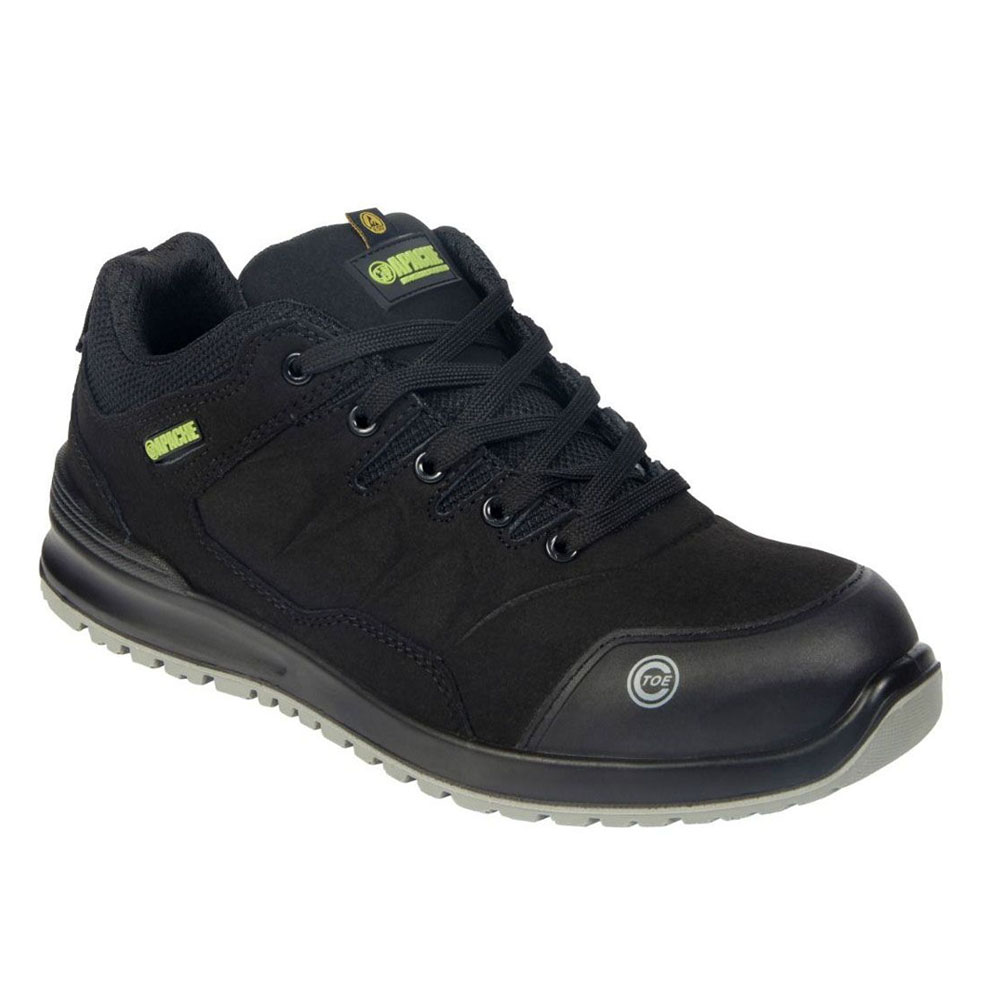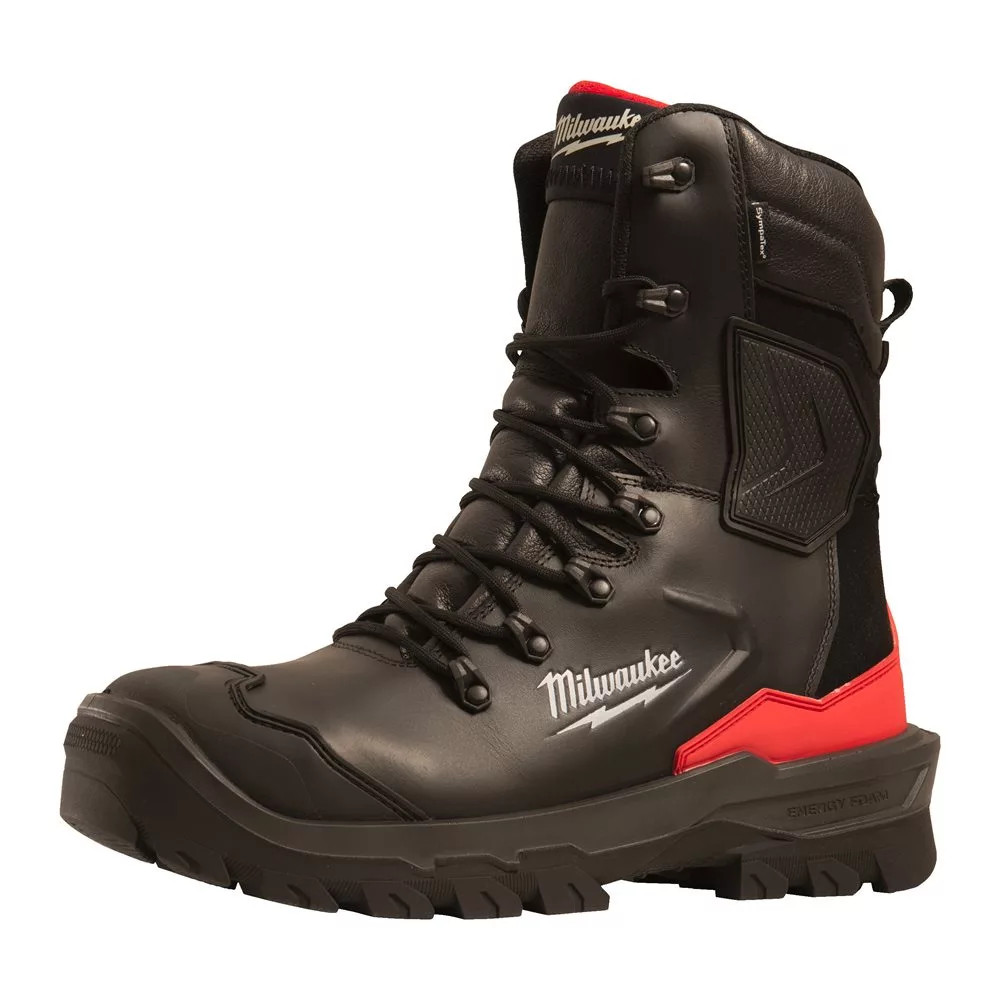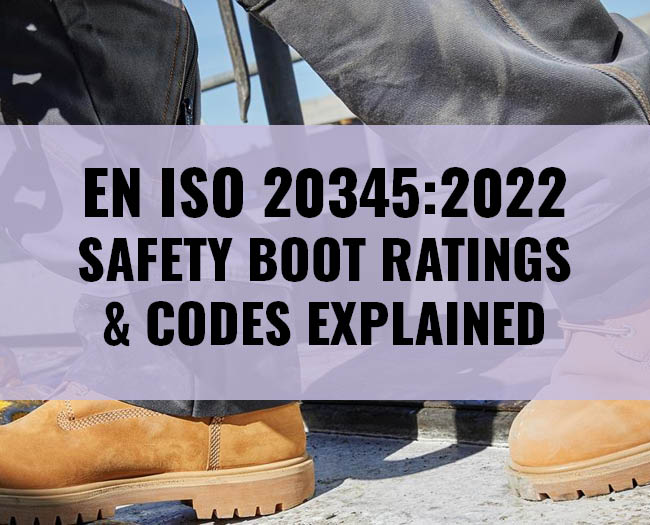Buying a pair of work boots or trainers should be simple. However, with various safety boot rating codes, it can be very confusing. Here, we explain precisely what each code means.
Safety Boots are an essential part of your PPE when working on site – whether it be someone’s home, garden or on a construction site.
When it comes to work boots there is so much to choose from – and how do you know if what you are choosing is the right thing considering that many worksite requirements vary from site to site?
We wanted to find out more, so we spoke to industry experts and workwear manufacturers to find out what every safety rating code means.
This article is the result of all that work, we hope this guide will help you decide what will work for you, and also clear up what each safety code means.

What Are The Legal Requirements for Safety Boots In The UK?
Before getting into the nitty gritty of the article it’s good to know why this all matters. All footwear in the UK must be EN ISO 20345:2022 compliant, and while that looks like a load of mumbo jumbo it makes sense when you break it down.
EN – Standard code for safety footwear across Europe.
ISO – This stands for International Organisation for Standardization. This means all products must meet their minimum standards.
20345 – This is the footwear legislation number.
2022 – Footwear standards were updated in 2022 and became much stricter. All footwear must have toe protection with at least 200 Joule impact protection as standard.
In 2022, the marking codes were updated from 2011 to give a better and more in-depth understanding of what each boot offers. The 2011 marking codes have either been expanded on or in some cases, replaced.
What are the Safety Boot Rating codes & Their Meanings?
Before you even enter any building site, demolition site or work site, there will be a sign explaining the different requirements you need to fulfill before entering. One of these requirements is safety boots.
Different sites, or even different areas of one site, will require that you wear the appropriate footwear to protect your feet in case of accidents. This list not only highlights each code but explains each one.
Basic Requirements
Each pair of safety boots will have one basic safety code assigned to it. This is to let you know what the footwear is capable of, and what level of protection it delivers. Below is a table of the different ratings.
| Safety Code | Explanation |
|---|---|
| CLASS I | Footwear made from leather and other materials |
| CLASS II | All entirely moulded footwear |
| SBH | HYBRID FOOTWEAR that cannot be classified as class I or ll |
| SB | Safety toe cap protection only, tested with 200J impact and 15KN compression force |
| SBP | Safety toe cap protection only, tested with 200J impact and 15KN compression force Metal Penetration resistant outsole – value shall not pass less than 1100N with no separation of layers SB, P |
| SBL | Safety toe cap protection only, tested with 200J impact and 15KN compression force Non Metal Penetration resistant outsole – value shall not pass less than 1100N with no separation of layers SB, PL |
| SBS | Safety toe cap protection only, tested with 200J impact and 15KN compression force Non Metal Penetration resistant outsole – Average penetration value shall not pass less than 1100N SB, PS |
| S1 | Class I – Footwear made from leather and other materials Closed heel area, Tested with 200J impact and 15KN compression force, Anti-Static Heel energy absorption SB, A, E |
| S1P | Class I – Footwear made from leather and other materials Closed heel area, Tested with 200J impact and 15KN compression force, Anti-Static Heel energy absorption Metal Penetration resistant outsole – value shall not pass less than 1100N with no separation of layers SB, A, E, P |
| S1L | Class I – Footwear made from leather and other materials Closed heel area, Tested with 200J impact and 15KN compression force, Anti-Static Heel energy absorption Non Metal Penetration resistant outsole – value shall not pass less than 1100N with no separation of layers SB, A, E, PL |
| S1S | Class I – Footwear made from leather and other materials Closed heel area, Tested with 200J impact and 15KN compression force, Anti-Static Heel energy absorption Non Metal Penetration resistant outsole – Average penetration value shall not pass less than 1100N SB, A, E, PS |
| S1PS | Class I – Footwear made from leather and other materials Closed heel area, Tested with 200J impact and 15KN compression force, Anti-Static Heel energy absorption Non Metal Penetration resistant outsole – Average penetration value shall not pass less than 1100N SB, A, E, PS |
| S2 | Class I – Footwear made from leather and other materials Closed heel area, Tested with 200J impact and 15KN compression force, Anti-Static, Heel energy absorption, Water penetration resistant upper SB, A, E, WRU |
| S3 | Class I – Footwear made from leather and other materials Closed heel area, Tested with 200J impact and 15KN compression force, Anti-Static, Heel energy absorption, Water penetration resistant upper, Metal Penetration resistant outsole – value shall not pass less than 1100N with no separation of layers Cleated Outsole SB, A, E, WRU, P |
| S3L | Class I – Footwear made from leather and other materials Closed heel area, Tested with 200J impact and 15KN compression force, Anti-Static, Heel energy absorption, Water penetration resistant upper Non Metal Penetration resistant outsole – value shall not pass less than 1100N with no separation of layers Cleated Outsole SB, A, E, WRU, PL |
| S3S | Class I – Footwear made from leather and other materials Closed heel area, Tested with 200J impact and 15KN compression force, Anti-Static, Heel energy absorption, Water penetration resistant upper Non Metal Penetration resistant outsole – Average penetration value shall not pass less than 1100N Cleated Outsoles SB, A, E, WRU, PS |
| S4 | All rubber or all polymeric anti-static footwear. Safety toe cap protection only, tested with 200J impact and 15KN compression force Anti Static Closed Heel Area Heel energy absorption SB, A, E |
| S5 | All rubber or all polymeric anti-static footwear. Safety toe cap protection only, tested with 200J impact and 15KN compression force Anti Static Closed Heel Area Heel energy absorption Cleated Outsoles Metal Penetration resistant outsole – value shall not pass less than 1100N with no separation of layers SB, A, E, P |
| S5L | All rubber or all polymeric anti-static footwear. Safety toe cap protection only, tested with 200J impact and 15KN compression force Anti Static Closed Heel Area Heel energy absorption Non Metal Penetration resistant outsole – value shall not pass less than 1100N with no separation of layers Cleated Outsole SB, A, E, PL |
| S5S | All rubber or all polymeric anti-static footwear. Safety toe cap protection only, tested with 200J impact and 15KN compression force Anti Static Closed Heel Area Heel energy absorption Non Metal Penetration resistant outsole – Average penetration value shall not pass less than 1100N Cleated Outsoles SB, A, E, PS |
| S6 | Class I – Footwear made from leather and other materials Closed heel area, Tested with 200J impact and 15KN compression force, Anti-Static, Heel energy absorption, Water penetration resistant upper Water resistant SB, A, E, WRU, WR |
| S7 | Class I – Footwear made from leather and other materials Closed heel area, Tested with 200J impact and 15KN compression force, Anti-Static, Heel energy absorption, Water penetration resistant upper, Metal Penetration resistant outsole – value shall not pass less than 1100N with no separation of layers Cleated Outsole Water Resistant SB, A, E, WRU, P, WR |
| S7L | Class I – Footwear made from leather and other materials Closed heel area, Tested with 200J impact and 15KN compression force, Anti-Static, Heel energy absorption, Water penetration resistant upper, Non Metal Penetration resistant outsole – value shall not pass less than 1100N with no separation of layers Cleated Outsole Water Resistant SB, A, E, WRU, P, WR, PL |
| S7S | Class I – Footwear made from leather and other materials Closed heel area, Tested with 200J impact and 15KN compression force, Anti-Static, Heel energy absorption, Water penetration resistant upper, Non Metal Penetration resistant outsole – Average penetration value shall not pass less than 1100N Cleated Outsole Water Resistant SB, A, E, WRU, P, WR, PS |
Additional Features
These additional features have, in some cases, been incorporated into the basic safety code. They also highlight further safety features on the boots which can be useful for the job.
| Safety Code | Explanation |
|---|---|
| A | Anti-Static – Electrical resistance between foot and ground between 0.1 and 1000 Mega Ohms |
| AN | Ankle Protection – 10N impact mean transferred force shall not exceed 10Kn and no single value shall exceed 15kN |
| C | Partially conductive footwear – electrical resistance will not be greater than 0.1 Mega Ohms between foot and ground |
| CI | Cold Insulation – Protection against the cold for 30mins at -17°C |
| CR | Cut resistant upper |
| E | Heel energy absorption |
| ESD | Electro-static dissipative footwear |
| FO | Resistant to Fuel Oil |
| HI | Heat insulation of outsole complex – 30mins at 150°C |
| HRO | Heat Resistant Outsole compound – withstands 300°C for 60secs |
| LG | Ladder Grip |
| M | Metatarsal protection up to 100J impact energy |
| P | Metal Penetration resistant outsole – value shall not pass less than 1100N with no separation of layers |
| PL | Non Metal Penetration resistant outsole – value shall not pass less than 1100N with no separation of layers |
| PS | Non Metal Penetration resistant outsole – Average penetration value shall not pass less than 1100N |
| SC | Scuff Cap Abrasion |
| SR | Slip Resistance. Tested on ceramic floor tile and glycerine. This replaces SRA, SRB & SRC |
| SRA | Slip resistance on ceramic tile flooring Footwear is tested on clay tiles with sodium lauryl sulphate solution and meets a minimum Coefficient (CoF) of Friction of 0.32 tested flat & CoF 0.28 tested at the heel. (CE EN ISO20345:2011) Code replaced by SR |
| SRB | Slip resistance on steel floor Footwear is tested on stainless steel with a glycerol solution and meets a CoF of 0.18 tested flat & 0.13 tested at the heel. (CE EN ISO20345:2011) Code replaced by SR |
| SRC | Footwear indicates both SRA & SRB are met. (CE EN ISO20345:2011) Code replaced by SR |
| WPA | Water Penetration and absorption |
| WR | Water Resistant footwear |
How Can I Use This Information to Make a Buying Decision?
Each job will have a different requirement for safety footwear as not every job is going to be the same. You can now use this table to find the precise boots or trainers you need for a job.
You now know that S1 boots are made from leather and other materials, have a closed heel area, and have been tested with 200J impact and 15KN compression force. Further, they are anti-static and offer heel energy absorption for additional comfort.
You also know that AN relates to Ankle Protection, SR is Slip Resistance and LG ensures a Ladder Grip on the soles.
Knowing this information allows you to make an informed decision when purchasing safety boots. For example, if you’re going to be working with water pumps or pressure washing equipment you’ll want a waterproof boot – using the table we can see that we want a boot with the WR additional feature.
Another example would be working in hot environments, for example, welding or glass making. We ideally want shoes that protect our feet from high-temperature accidents, so using the table we can see that HI or HRO will offer me varying levels of heat protection.
Real World Examples
Still confused? OK, let’s put this into perspective. Below are examples of shoes and trainers that we have picked out to help explain what to look for with safety codes.
Apache Brampton Suede Safety Trainers (Black) Safety Code Explained
Lets take the Apache Brampton Suede Safety Trainers (Black) as an example. The safety codes on these trainers are S3S, SR, ESD This means;

| Safety Code | Explanation |
|---|---|
| S3 | Class I – Footwear made from leather and other materials Closed heel area, Tested with 200J impact and 15KN compression force, Anti-Static, Heel energy absorption, Water penetration resistant upper, Metal Penetration resistant outsole – value shall not pass less than 1100N with no separation of layers Cleated Outsole |
| C | Slip Resistance. Tested on ceramic floor tile and glycerine. This replaces SRA, SRB & SRC |
| ESD | Electro-static dissipative footwear |
S3 Tells us these trainers are made from leather and other materials with a closed heel area and have been tested with 200J impact and 15KN compression force.
The ESD rating lets us know they’re anti-static, have comfortable heel cushions, and offer water resistancy on the top of them. There is a metal penetration protection and a cleated outsole.
Finally, C shows they are slip-resistant and can be used in/around electricity.
Milwaukee ARMOURTRED S7S Safety Boots Safety Code Explained
Here’s a heftier example, a recent and popular arrival is the Milwaukee ARMOURTRED S7S Safety Boots. These have a safety code of
S7S, CI, AN, HRO, SC, FO, LG, SR. This means;

| Safety Code | Explanation |
|---|---|
| S7S | Class I – Footwear made from leather and other materials Closed heel area, Tested with 200J impact and 15KN compression force, Anti-Static, Heel energy absorption, Water penetration resistant upper, Non Metal Penetration resistant outsole – Average penetration value shall not pass less than 1100N Cleated Outsole Water Resistant |
| CI | Cold Insulation – Protection against the cold for 30mins at -17°C |
| AN | Ankle Protection – 10N impact mean transferred force shall not exceed 10Kn and no single value shall exceed 15kN |
| HRO | Heat Resistant Outsole compound – withstands 300°C for 60secs |
| SC | Scuff Cap Abrasion |
| FO | Resistant to Fuel Oil |
| LG | Ladder Grip |
| SR | Slip Resistance. Tested on ceramic floor tile and glycerine. This replaces SRA, SRB & SRC |
These boots hold an S7S rating so they are made from leather and other materials with a closed heel area and have been tested with 200J impact and 15KN compression force. They’re also anti-static, have comfortable heel cushions, and offer water resistancy on the top of them. There is a metal penetration protection and a cleated outsole all while keeping your feet warm as well as protecting your ankles from side impacts (AN).
They can be worn across hot surfaces (HRO), offer protection against scuffs (SC) if scratched across an abrasive material along with helping keep you balanced if you walk through oil (FO).
They are also slip-resistant (SR) and have a defined grip to keep you secure on ladders (LG). Basically, they’re pretty darn good boots.
You can see why, after this, you need the codes.
FAQ
What Does The SB Rating Mean?
SB means Safety Basic – it is the basic requirement offered by any footwear that can be classed as safety footwear. As an absolute minimum, each boot or trainer must be able to withstand an impact of 200J.
That’s the same as a stack of about 40-50 standard bricks being dropped…on your toes.
What are Slip Resistant Ratings and What Do They Mean?
The 2011 codes had slip resistance as three separate codes. This has now been replaced by one code – SR. However, as many boots and trainers still use the 2011 codes, we’ve kept it in to highlight the differences.
SRA – Slip resistance on ceramic tile flooring
SRB – Slip resistance on steel floor
SRC – Slip resistance on steel floor and on ceramic tile flooring.
What’s The Difference Between Steel, Composite And Aluminium Toe Caps?
Steel toe caps use a piece of formed steel to protect your toes. The same with aluminum. Composite toe caps use a mixture of plastics, carbon fibres and/or rubber. Steel will be heavier while the composite will be more lightweight. If you’re moving around a lot, you might find that the steel caps will feel uncomfortable after periods of movement. That said, the generally offer the greater protection than composite caps.
What is the difference between S3 and S7 boots?
The S3 and S7 boots are very similar to each other, but with a few key differences.
Both levels of footwear are made from leather and other materials, have a closed heel area and have been tested with 200J impact and 15KN compression force (stack of bricks – see above)
They’re both anti-Static, offer heel energy absorption, and include water penetration resistant upper while also including a metal Penetration resistant outsole
However, as a standard for the code, the S7 also incorporates complete water resistancy – they’re waterproof.
What is the Current British standard for safety shoes?
All footwear in the UK must be EN ISO 20345:2022 compliant, and while that looks like a load of mumbo jumbo it makes sense when you break it down.
EN – Standard code for safety footwear across Europe.
ISO – This stands for International Organisation for Standardization. This means all products must meet their minimum standards.
20345 – This is the footwear legislation number.
2022 – Footwear standards were updated in 2022 and became much stricter. All footwear must have toe protection with at least 200 Joule impact protection as standard.
What is the best Safety Boot/Trainer for me?
Each work environment will have different requirements for PPE. And even when you get to the site, different areas may have different safety requirements.
For example – if you’re in a refueling area, there could be very little need for a ladder grip. Likewise, if you’re working with wet cement, it is unlikely that you’ll need Anti-Static boots.
The best advice we can offer is to check before turning up to site, what requirements are needed.

